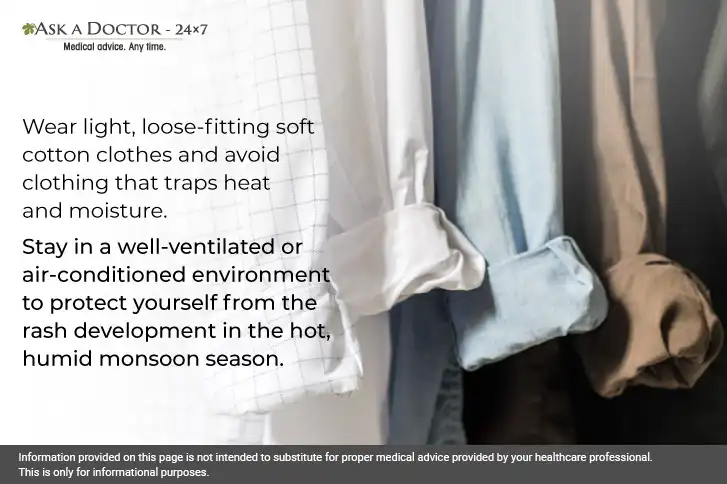Common Monsoon Skin Infections And Solutions To Fix Them
Who doesn’t like rain? Beyond providing respite from the dryness of summer, the monsoon rain brings a palpable sense of positivity and relief in the air. The dust-free, vibrant green surroundings, cold, cozy, and breezy days, lovely evenings, and long romantic drives - Monsoon is indeed beautiful! But, these pleasant rains bring along with them a plethora of not-so-pleasant skin infections too. Sounds worrisome, Isn’t it? Do not bother, as here in this blog, we have unveiled the solutions to your common monsoon skin woes.
Read on to shine through the rain this monsoon season.…
How Does Monsoon Affect Our Skin?

In monsoon season there is a high rise in the humidity in the environment. And as fungi generally thrive in hot and humid conditions, it makes our skin prone to various issues. The high temperature with increased sweating causes ringworm in body folds like the groin areas, beneath the breasts, and between the toes leading to itch and unavoidable discomfort.
Further to this many other skin issues like acne breakout, skin peel, and allergic rashes on the hands, upper back, feet, and other exposed areas of the body are commonly observed in the monsoon humid conditions.
Solutions to 5 Common Monsoon Skin Infections

Find here the solution to your beauty woes to shine through the rain this monsoon:
1. Act on acne
Oily skin and acne are pestering. Take a little extra care of your skin this season to clean it from any sort of microbial organisms that thrive in this season. Keep your skin dry, and use homemade mud packs, face packs, and scrubs to get rid of dead cells.
2. Tame your tresses
No one likes frizzy, dull hair. But this is exactly what rains do to our hair. It happens due to the excessive moisture in the air. To ease the frizz, you should use gentle, chemical-free hair cleansers. Also, it is only advisable to stay away from any sort of chemical treatments for hair in this season.
3. Fight fungal infections
Watch out for any fungal infection on your feet. Feet are usually the most worn out and also neglected part of the body. The water-logged streets cause water to get inside the footwear, thereby leading to fungal infections. Don’t ignore your feet and wash them properly with anti-bacterial soap and liquid every time you come from outside. Keep your feet dry, and avoid any moisturizing lotions or creams this season.
4. Treat excessive sweating
This hot and humid climate causes excessive sweating, which can lead to body odor and consequent infections. Armpits, face, feet, scalp, and palms need special attention through maintaining personal hygiene. Don’t skip the daily bath ritual, and use anti-fungal powder to keep the skinfold area dry. Antiperspirant lotions and deodorants can also be used.
5. Slay your skin rashes
No matter how irresistible the pitter-patter of the raindrops sounds to the ears, getting drenched in rain in such a highly polluted time is only an invite to skin allergies and rashes. Staying away from dirty water is the only way to protect your skin. You can also apply aloe vera gel, or a mixture of tea-tree oil and coconut oil to soothe mild rashes.
Conclusion
You can rain-proof your skin by maintaining proper hygiene, consuming a lot of fluids, eating fresh fruits, and including Vitamins C, E, and Omega-3 in your daily diet. However, in case any condition persists for long, don’t delay a visit to your doctor.
For any queries related to skin infections, you can Ask a Dermatologist online, either through chat, phone call, or video consultation at Ask a Doctor 24x7.
Recently Answered Questions Related Monsoon Skin Infection
- Suggest Medication For Hairfall During Monsoon
- Suggest Treatment For Itching Boils With Scarring Predominantly In Monsoon
- Please Suggest Me Remedy For Running Nose, Headache, Watery And Itchy Eyes
- Suggest Treatment For Rashes between the Thighs
- Suffering From Asthma Bronchiale. Which Specialist Should I Consult?
- What Is The Cause And Treatment For Tinea Pedis?
- Suggest Treatment For Fungal Infection On-Ear Causing Itching
- Suggest Treatment For Fungal Infection Between Toes
- Suggest Treatment For Skin Infection
Disclaimer: Information provided on this page is not intended to substitute for proper medical advice provided by your healthcare professional. This is only for informational purposes.
Ask a Specialist
Recent Questions


